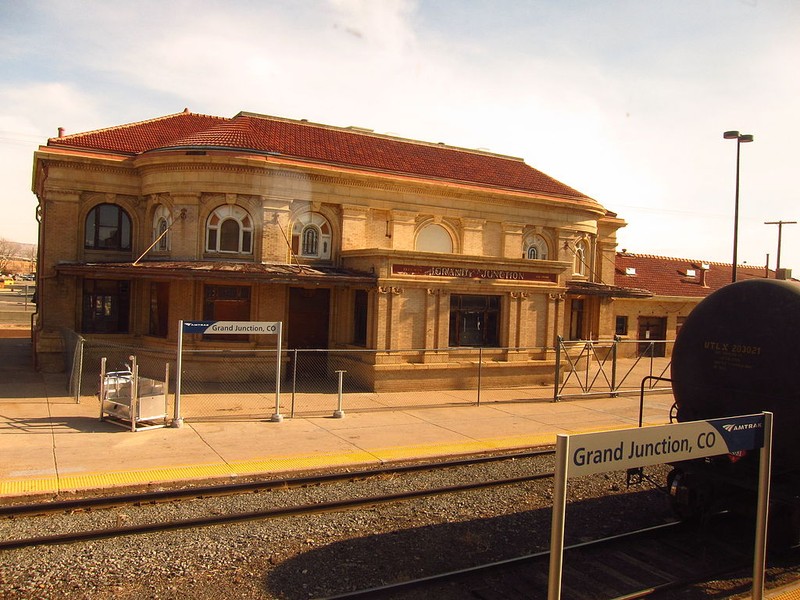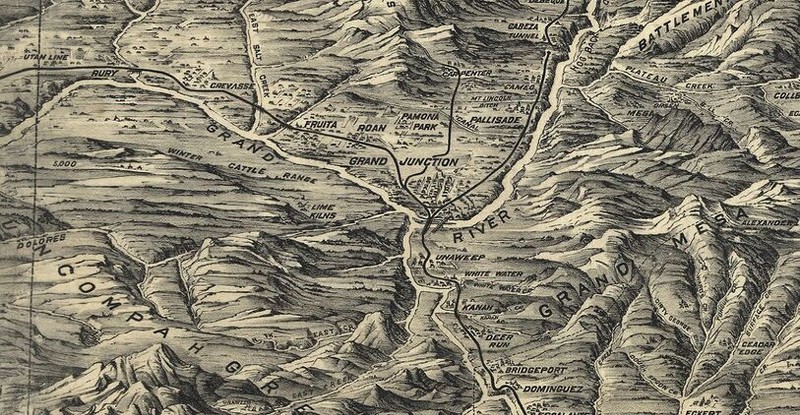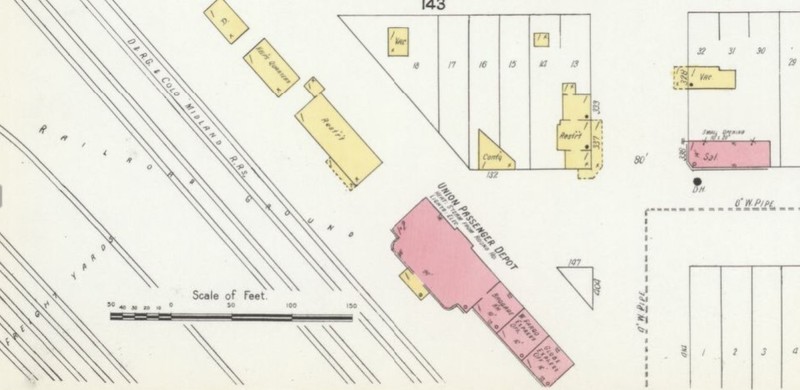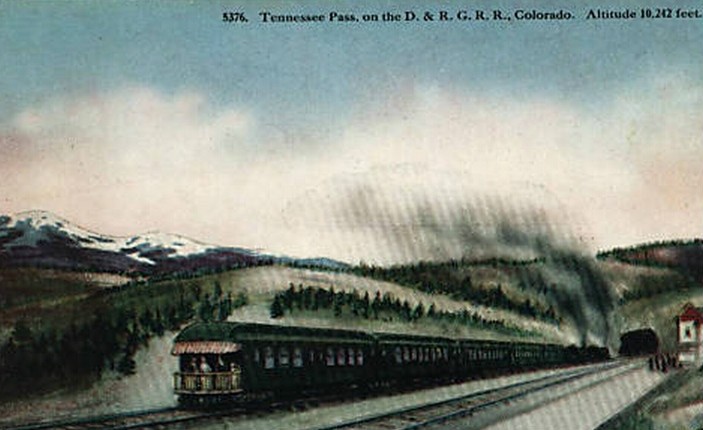Denver & Rio Grande Western Railroad Depot
Introduction
Text-to-speech Audio
Images
2012 photograph of railroad tracks-facing side of D&RGW depot (Egaowakaii)

1894 birds-eye relief map of Grand Junction vicinity (Pezolt & McConnell)

Railroad station on 1907 Sanborn map of Grand Junction, Mesa County, Colorado (Sanborn Map Company, p. 10)

Postcard image of D&RGW train at Tennessee Pass, Colorado, circa 1910s-1920s (HHT Co.)

Backstory and Context
Text-to-speech Audio
The Denver & Rio Grande Western (D&RGW) Railroad Depot has anchored the town's railroad stop since 1905. The Italian Renaissance style building constructed of white brick was the design of Henry J. Schlack and was built by the William Simpson Construction Company. The building was decorated with terra cotta ornamentation and covered by a tile roof. Arched, stained glass windows on the second floor gave the building a distinctive look.
The D&RGW company began in 1870 with a narrow-gauge rail line heading south from Denver by 1871. The line headed west across the Rocky Mountains to the mining town of Leadville. From Leadville, the line headed further west, over Tennessee Pass, to Grand Junction. The Royal Gorge Route passed through Canon City in 1874, reached Salida and Leadville in 1880, reaching Montrose in 1882. A line was laid north from Montrose through Delta, finally reaching Grand Junction in March 1883.
One of the partners in the company, William Bell, began another rail line, the Denver & Rio Grande Western. This line began in the coal-rich areas of Utah and headed west into Colorado. The two lines met in 1883 near Green River, west of Grand Junction.
The first station at Grand Junction was a log structure. The D&RG bought a substantial swath of land adjacent to the depot to establish a repair facility and switchyard. The railroad was soon one of the area's largest employers, bringing an influx of new workers, mainly immigrant labor. As the new town grew, a Queen Anne style, 2-story depot was built. A sugar beet boom doubled the town's population in the first years of the twentieth century, and a larger depot was needed for the four rail lines operating out of the town.
The masonry structure that became the third train station in Grand Junction was initially named the "Union Passenger Depot." The building was heated by steam from the round house and had electric lights in 1907. The depot was adjacent to a restaurant and a dwelling along the tracks in 1907, with two other restaurants and a saloon within steps of the depot on the adjacent street, E. Pitkin Avenue. The main block of the depot featured a spacious waiting room on the first floor with railroad offices above. The three one-story spaces in the attached wing held a baggage room, the Wells Fargo Express Office, and the Globe Express office.
The US Railroad Administration took over the rail line during World War I. The D&RG rail company fell into receivership and was reorganized in 1921. Bankruptcy occurred again in 1935, but by 1947, the line was back in business. The railroads switched from steam engines to diesel in the 1950s. The rails at Grand Junction continued to be busy due to the area's coal, oil and gas development. The DR&G gave up the passenger route in 1983 and it was incorporated into Amtrak. The depot at Grand Junction was no longer being used by Amtrak after 1992, which moved to another nearby building that was deemed safer. The depot has been stabilized by historic preservation efforts to save the vacant structure.
Sources
Encyclopedia staff. Grand Junction Depot, Colorado Encyclopedia. December 28th 2017. Accessed February 29th 2020. https://coloradoencyclopedia.org/article/grand-junction-depot.
Fraser, Clayton B.. Strand, Jennifer H. . NRHP Multiple Property Listing Nomination Form for Railroads in Colorado 1858 - 1948. National Register. Washington, DC. National Park Service, 1997.
History Colorado. Denver & Rio Grande Western Railroad Depot, Mesa County, National and State Registers. January 1st 2020. Accessed February 26th 2020. https://www.historycolorado.org/location/denver-rio-grande-western-railroad-depot.
History Colorado. Railroads in Colorado, 1858-1948, National and State Registers. January 1st 2020. Accessed February 26th 2020. https://www.historycolorado.org/railroads-colorado-1858-1948.
https://commons.wikimedia.org/wiki/File:Amtrak_station_in_Grand_Junction,_CO.JPG
Library of Congress Geography & Maps Division, digital ID http://hdl.loc.gov/loc.gmd/g4310.ct000610
Library of Congress Geogrpahy & Maps Division (Digital ID http://hdl.loc.gov/loc.gmd/g4314gm.g010071907)
https://en.wikipedia.org/wiki/Denver_and_Rio_Grande_Western_Railroad#/media/File:Denver_and_Rio_Grande_Western_train_at_Tennessee_Pass.JPG
